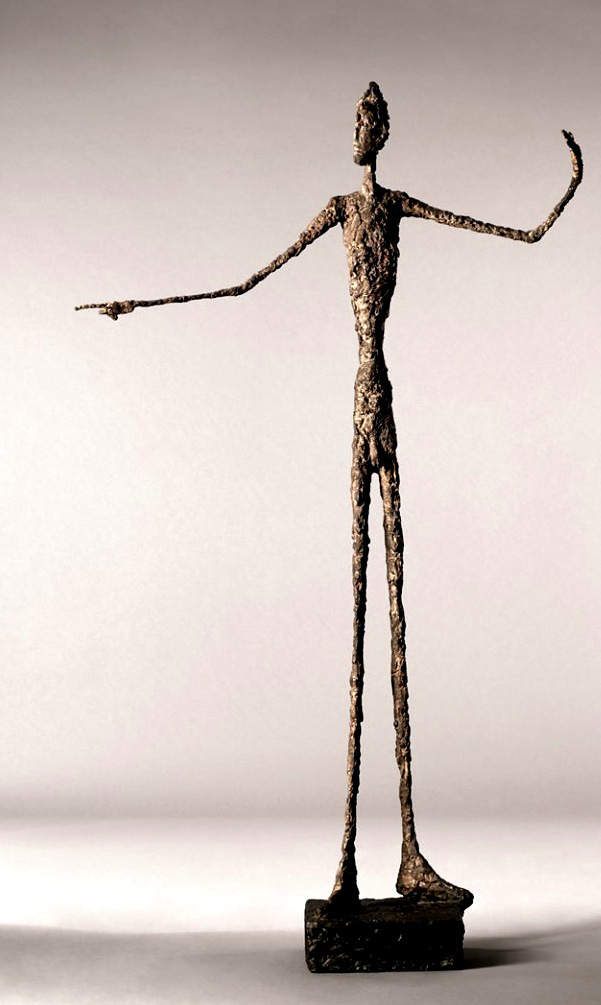Folks often ask me, "What's with the long limbs?" And to be honest, I really don't have a satisfying answer to that question. Believe me, I've dissected it hundreds of times and have a couple of suspicions why I tend toward the tall:
- I like climbing (trees, rocks, buildings; I'm not picky) and relish the vantage point that climbing allows. Perhaps the joy I get from creating tall figures is through imagining the view they must enjoy.
- I grew up in the flattest flatty flat-town on this flat Earth: eastern South Dakota (Tulare, population 207). Because of the unending farmland that surrounds my hometown, tall objects rise dramatically from the land below and can be seen from miles around. Thus, water-towers, lone trees, and grain elevators are the only obelisks to puncture the sky. I spent countless hours staring at these monoliths in wonder and awe. Perhaps my fascination with tall figures is how they tower above the landscape, much like the towering structures of my youth.
The entire town of Tulare, SD all in one frame. My hometown and a little chunk of Midwest heaven.
Neither of these theories seem to fully fit the bill, but I doubt that I'll ever find a full explanation. What I do know is that there are a few theories I often hear that I can quickly dispel:
- I really wish I was tall and my figures represent this desire. (I am quite happy at 5'11'').
- I take drugs before I paint (drugs are not a part my process, unless you count the occassional late-night beer or whiskey).
- Slender Man haunts my dreams (I have no association with this fictitious supernatural character from the horror genre. He was created in 2009, years after I had started my making my lanky fellas. Also, scary movies actually scare me and I don't like that.)
Questions about an artist's stylistic choices and their presumed meanings are most often answered post-mortem by "experts", so I don't feel that it's worth spending too much time scrutinizing why I make my figures tall.
Perhaps, then, it'd be more fruitful to analyze another artist well known for their thin, lanky figures and who also happens to be one my greatest influences: Alberto Giacometti.
Alberto Giacometti at the 31° Venice Biennale in 1962, photographed by Paolo Monti.
Giacometti is a fascinating artist whose work has sent ripples through the art community that continue to wash over today's contemporary artists. He was born in a small village in the Swiss Alps and took to art from an early age. When he was only ten, he began to send crayon and pencil drawings to his godfather Amiet and he created his first painting at age twelve.
In 1922, at the age of 21, Giacometti moved to Paris where he began to produce the bulk of his work in a squalid 240 square foot apartment. The space was meager (a tree branch later began to grow through one of the walls) but he loved it there and it proved to be a fruitful studio.
Alberto Giacometti painting in his Paris studio, 1958. Credit: Stiftung Ernst Scheidegger/Archiv, Zurich
Giacometti's early work was more abstract and surreal, drawing from his unconscious mind to create compositions. His surreal sculptures, in particular, are regarded as some of the most important of their kind, achieving tension without relying on representational forms. There is a certain beauty to his shapes (and some argue an underlying sexuality), but it his later elongated figures that excite me the most.
Alberto Giacometti, "Suspended Ball," 1930-31.
Right as Giacometti was really beginning to pick up steam as an artist, the world was catapulted into World War II and he was forced to flee his Paris studio for the safety of ever-neutral Switzerland. Once the fighting had died down, Giacometti returned to Paris but like so many people the world over, the war had changed him.
His once graceful abstract forms grew increasingly long, reduced to their core existence. Looking at them now, they carry a certain doubt and melancholy, presumably brought on by watching the whole of Europe erupt into horrific bloodshed. It is said that he was heavily self-critical and that his figures are so diminished because he would continually rework and reduce them. Another scholar sees his sculptures as "lone trees" and I feel that this perfectly captures their appeal to me. They are lone beacons of emotion meant to stir the viewer; to engage the viewer's inner core by exposing theirs.
Albert Giacometti, "The Clearing"
In these bleak, skeletal structures however, there is optimism and hope to be found. Giacometti although famously plagued by self-doubt, never stopped creating until his death at age 66. Most artists I know (including myself) are self-critical, whether it finds the surface of their personality or not. It is this demon that lives in the studio, trying to weigh down the paintbrush or pen, hoping to plug the wellspring of creativity and bring "the work" to a grinding halt. Writer's block, creative slowdown, a slump; it goes by many names.
But I believe that at the heart of this creative paralysis is doubt. And at the core of doubt is fear. While Alberto Giacometti is widely known for capturing the heaviness that life can sometimes bring, he never let his fear overcome his passion. And that, my friends, is one tall order.
Albert Giacometti, "Pointing Man," This sculpture set a record when it sold for $141.3 million in 2015






